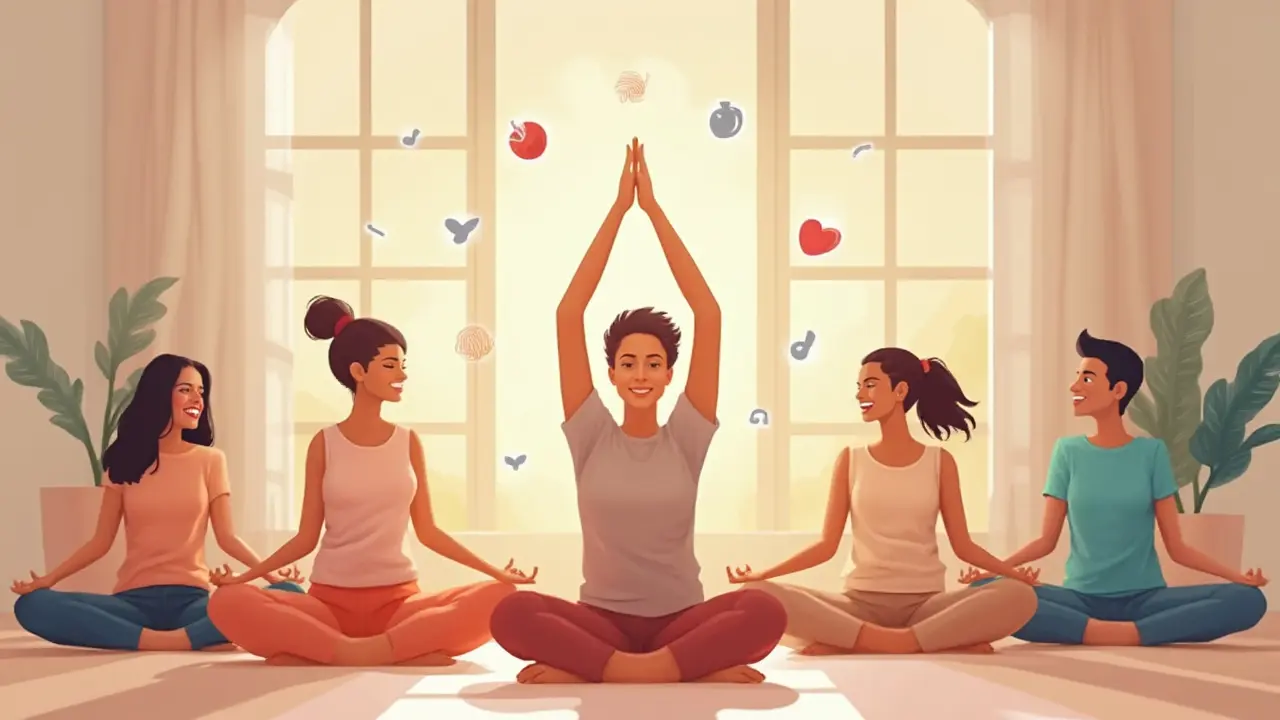Body Massage: Your Guide to Wellness and Relaxation

Ever wondered why you feel so much lighter after a good massage? There’s more going on than just relaxing muscles. Massage gets your blood flowing and dials down stress chemicals like cortisol. That’s why your shoulders drop and your thoughts actually slow down for once.
It’s not just about pampering yourself, either. Consistent body massage can help you bounce back faster from workouts, recover from long hours hunched over a screen, and even sleep better. A bunch of people working from home noticed fewer headaches and backaches when they added massage to their routine. If you’ve got nagging pain or just can’t switch off mentally, massage easily fits into a low-maintenance self-care plan.
The best part? You don’t need to know anything fancy to start. Just understanding the basics can help you pick the right kind of massage and get more out of each session. Stick around for the need-to-know details, practical tips, and a few things you won’t find posted at your local spa.
- Why Massage Works
- Popular Types of Body Massage
- What to Expect During a Session
- Tips for Maximizing Your Massage
Why Massage Works
There’s real science behind why a body massage boosts your well-being. When someone works on tired muscles, it isn’t just about kneading out tension—it changes what’s happening inside your body. Massage helps send more blood to your muscles, which means better oxygen and nutrient delivery. That’s how aches and pains fade a lot faster than if you just ignored them.
Regular massage sessions help drop stress hormones and ramp up endorphins, which are your body’s natural mood boosters. A 2022 study from the University of Miami found that people who received twice-weekly massages for a month showed a 31% drop in cortisol, the main stress hormone. Plus, serotonin and dopamine saw a noticeable bump—perfect for days when you feel like you’re running on empty.
It’s also about undoing the damage from sitting at a desk or training hard at the gym. Massage targets those sticky knots—called trigger points—and helps your muscles relax and repair. You’ll notice less stiffness and even better flexibility, which comes in handy whether you’re lifting weights or just trying to touch your toes.
Check out these quick facts about massage benefits:
| Benefit | How Fast You'll Notice | Bonus Effect |
|---|---|---|
| Less muscle soreness | Right after first session | Improved range of motion |
| Lowered stress | Within 2-3 sessions | Better sleep |
| Improved blood flow | After 1 session | Faster injury recovery |
| Fewer headaches | After 2-4 weeks | More energy |
One more thing—massage won’t cure everything, but it does make a real difference for most people. If you want your body to perform better and your mind to stop spinning, working body massage into your routine is a no-brainer.
Popular Types of Body Massage
When it comes to body massage, there are a bunch of styles out there—not all of them feel the same or offer the same perks. Picking the right one for your needs can make a big difference in how you feel afterward. Here’s a breakdown of the most popular types you’ll come across, plus what each one actually does for you.
- Swedish Massage: The classic. This is what most people picture when they think of a massage session. It uses long, gliding strokes and light to medium pressure, aiming mainly for relaxation and better blood flow. Great for first-timers or anyone just looking to chill.
- Deep Tissue Massage: Best for stubborn aches and tight spots. Therapists use slower, stronger pressure to reach deeper muscle layers. It’s popular among athletes, desk workers, and anyone carrying knots in their back or shoulders.
- Sports Massage: This style targets people who are active, but you don’t have to be a pro athlete to benefit. It often combines stretching and focused muscle work, helping with recovery, injury prevention, or prepping your body for activity.
- Thai Massage: No oils or lotions needed here. Instead, you stay clothed and the therapist uses a lot of stretching, pulling, and pressures, almost like assisted yoga. Good for improving flexibility and full-body energy boosts.
- Hot Stone Massage: Heated stones are placed on your body or used during strokes. The warmth melts away tension, and people swear by it for easing stress or muscle stiffness in colder months.
Want to know what massage therapists say about picking the right style? Check this out:
"Massage is not just a luxury. It's a way to a healthier, happier life. The right type can help manage pain, improve sleep, and make daily stress manageable." — American Massage Therapy Association
Each type has its sweet spot. For instance, if deep tissue sounds intense, keep in mind that while 74% of people who try it say their mobility improves, about 25% find it too strong for comfort (source: AMTA 2023 survey). If you’re unsure, Swedish is the safest pick—almost every spa offers it, and it’s suitable for nearly all ages.
| Massage Type | Average Duration (mins) | Main Benefit | Best For |
|---|---|---|---|
| Swedish | 50-60 | Relaxation | Anyone new to massage |
| Deep Tissue | 45-90 | Chronic pain relief | People with knots, athletes |
| Sports | 30-60 | Injury prevention | Active individuals |
| Thai | 60-90 | Flexibility | Those needing stretching |
| Hot Stone | 60-75 | Deep relaxation | Anyone with muscle tension |
The trick is to match your goals—more energy, less pain, or just serious downtime—with the right massage type. There’s no wrong answer, just whatever works best for you and your body.

What to Expect During a Session
Walking into a massage room for the first time? Here’s what actually happens, minus the weird surprises. Most places ask you to fill out a quick health form before you start. This helps your massage therapist know about any injuries, allergies, or specific spots that need attention.
Once you’re in the room, you’ll be given privacy to undress to your comfort level (and yes, you’re always covered except for the area being worked on). Most sessions last from 60 to 90 minutes. The room usually stays warm, and there’s often calming music, but if it’s too much or not your thing, just ask them to adjust it.
If you’ve booked a specific style, like deep tissue or Swedish, your therapist should explain what to expect. They’ll check in about pressure—don’t be shy if you need it lighter or firmer. Your comfort matters way more than being polite.
- Don’t worry if you fall asleep—it's common, especially when you’re exhausted.
- It’s totally normal to chat or stay quiet—whatever helps you relax.
- If something hurts or seems off, say something right away.
- Expect to feel calm and sometimes a little “floaty” after. Drink water to help your muscles recover.
Here’s a quick look at what clients usually experience during their body massage sessions, based on recent industry surveys:
| What Happens | How Common (2024 survey) |
|---|---|
| Asked about health issues & preferences | 95% |
| Room temperature adjusted for comfort | 78% |
| Music played during session | 88% |
| Offered water after session | 81% |
| Pressure level checked by therapist | 93% |
If you leave the table feeling more relaxed but a little lightheaded, you’re not alone. Drink some water, take a few minutes before driving, and don’t rush back to emails. That’s how you get the best out of every session.
Tips for Maximizing Your Massage
If you’ve ever left a massage wishing it lasted longer or did more, you’re definitely not alone. There are a few smart moves to make every session count, whether you get bodywork often or just once in a blue moon.
- Speak Up About Preferences: Don’t be shy about telling your therapist what hurts or what you want worked on. If you like more or less pressure, say so. It’s your time.
- Time Your Meals: Try not to eat a big meal right before. A full stomach makes it tough to relax and can be uncomfortable on the table.
- Hydrate Before and After: Drinking water helps your muscles relax and encourages your body to flush out waste products. Aim for a glass or two before, and plenty after.
- Arrive Early: Rushing in at the last second just amps up your stress. Get there a few minutes before your appointment to settle in.
- Turn Off Your Phone: Seriously, put it on silent. Distractions kill the vibe and make it harder for your mind to slow down.
Ever tried stretching after a massage? Loosening up while your muscles are still warm can boost flexibility. And if you’re dealing with soreness the next day, that’s pretty normal—especially after deep work. A warm bath or foam rolling can speed up recovery.
Massage pros often say the biggest results come when you make sessions a habit. Monthly appointments can help maintain benefits, especially for muscle pain or stress. Here’s a quick rundown that shows how often different people get massages and what they notice:
| Frequency | % of People | Main Benefit Reported |
|---|---|---|
| Once a week | 20% | Pain relief, faster exercise recovery |
| Once a month | 40% | Reduced stress, fewer tension headaches |
| Every few months | 40% | Relaxation, general wellness |
One last thing—trust your gut. If something feels off during the body massage, let your therapist know right away. Your comfort is key to getting the most out of every dollar and every minute on the table.
